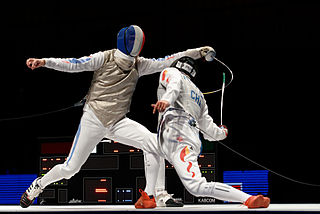
Fencing is a group of three related combat sports. The three disciplines in modern fencing are the foil, the épée, and the sabre ; winning points are made through the weapon's contact with an opponent. A fourth discipline, singlestick, appeared in the 1904 Olympics but was dropped after that, and is not a part of modern fencing. Fencing was one of the first sports to be played in the Olympics. Based on the traditional skills of swordsmanship, the modern sport arose at the end of the 19th century, with the Italian school having modified the historical European martial art of classical fencing, and the French school later refining the Italian system. There are three forms of modern fencing, each of which uses a different kind of weapon and has different rules; thus the sport itself is divided into three competitive scenes: foil, épée, and sabre. Most competitive fencers choose to specialize in one weapon only.

A parry is a fencing bladework maneuver intended to deflect or block an incoming attack.

The épée, sometimes spelled epee in English, is the largest and heaviest of the three weapons used in the sport of fencing. The modern épée derives from the 19th-century épée de combat, a weapon which itself derives from the French small sword.
In fencing, a displacement is a movement that avoids or dodges an attack.
The remise is a renewal of an attack in fencing. It is performed when one fencer's attack has failed, either because their opponent has parried or they missed. If the attacker immediately continues their attack in the same line, they have executed a remise. The name also is applied to repetitions of other actions which did not initially succeed. The remise is at the bottom of actions in taking priority.
Classical fencing is the style of fencing as it existed during the 19th and early 20th centuries. According to the 19th-century fencing master Louis Rondelle,
A classical fencer is supposed to be one who observes a fine position, whose attacks are fully developed, whose hits are marvelously accurate, his parries firm and his ripostes executed with precision. One must not forget that this regularity is not possible unless the adversary is a party to it. It is a conventional bout, which consists of parries, attacks, and returns, all rhyming together.

The sabre is one of the three disciplines of modern fencing. The sabre weapon is for thrusting and cutting with both the cutting edge and the back of the blade.

Fencing – family of combat sports using bladed weapons. Fencing is one of four sports which have been featured at every one of the modern Olympic Games. Also known as modern fencing to distinguish it from historical fencing.

In fencing, an attack is "the initial offensive action made by extending the arm and continuously threatening the opponent's target". In order for an attack to be awarded successfully, the fencer must accelerate their hand towards the target. If the fencer does not accelerate the hand, this is a preparation.
Rapier Combat is a style of historical fencing practiced in the Society for Creative Anachronism (SCA). The primary focus is to study, replicate and compete with styles of rapier sword-fighting found in Europe during the Renaissance period, using blunted steel swords and a variety of off-hand defensive items. Participants wear period clothing while competing, along with or incorporating protective equipment for safety. In the April 2020 update of the rules, the sport was renamed 'Fencing Combat'.

The flick is a technique used in modern fencing. It is used in foil and to a lesser extent, épée.

The flèche is an aggressive offensive fencing technique used with foil and épée.

Jean-Louis Michel (1785–1865) was a Haitian master in the art of fencing, sometimes hailed as the foremost exponent of the art of fencing in the nineteenth century.
In martial arts, the terms hard and soft technique denote how forcefully a defender martial artist counters the force of an attack in armed and unarmed combat. In the East Asian martial arts, the corresponding hard technique and soft technique terms are 硬 and 柔, hence Goju-ryu, Shorinji Kempo principles of go-ho and ju-ho, Jujutsu and Judo.
Priority or right of way is the decision criterion used in foil and sabre fencing to determine which fencer receives the touch, or point, when both fencers land a hit within the same short time-frame. After this window, if one fencer had already landed a hit, the electrical scoring apparatus would "lock-out," or fail to record, an opponent's subsequent hit, and thus the one fencer to land a hit is awarded the touch. In épée fencing, if both fencers land valid hits at the same time, they each receive a point. Because of this, foil and saber are considered conventional weapons. After a halt, a referee parses what happened into actions, from which it can be determined whether to award a point or not.
Fencing practice and techniques of modern competitive fencing are governed by the Fédération Internationale d'Escrime (FIE), though they developed from conventions developed in 18th- and 19th-century Europe to govern fencing as a martial art and a gentlemanly pursuit. The modern weapons for sport fencing are the foil, épée, and sabre.

Defence Day is celebrated in Pakistan as national day to commemorate the sacrifices made by Pakistani soldiers in defending its borders. The date of 6 September marks the day in 1965 when Indian troops crossed the international border to launch an attack on Pakistani Punjab, in a riposte to Pakistan's Operation Grand Slam targeting Jammu. While it is officially commemorated as an unprovoked surprise attack by India, which was repulsed by the Pakistan Army despite its smaller size and fewer armaments.

Anja Fichtel-Mauritz is a German fencer. At the 1988 Summer Olympics in Seoul, she won in the individual and team competitions, and she won the individual competition of the World Championship in 1986 and 1990. She was winner of the World Championships in 1985, 1989, 1993 as a member of the national German team and second in team competition at the 1992 Summer Olympics. From 1986 until 1996 Fichtel held the title of German champion.

Tactics are very important to playing well in modern fencing and although technique is important in the sport, using an array of tactics will help fencers make the most of that technique.
This is a glossary of terms used in fencing.












